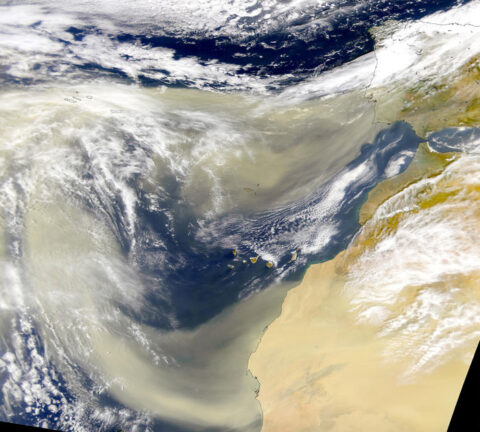Source: Geophysical Research Letters
The productivity of the Amazon rain forest, which plays a crucial role in regulating Earth’s climate, is limited by the availability of nutrients, especially phosphorus. Because water runoff keeps depleting this key nutrient from the basin’s old and low-phosphorus soils, previous studies have suggested the Amazon’s long-term productivity must depend upon dust transported from a distance source such as the Sahara. This foreign source of phosphorus, however, is not well quantified, and large discrepancies exist between current measurements and model estimates.

To resolve these discrepancies, Yu et al. published the first multiyear (2007–2013) satellite-based estimate of dust deposition in the Amazon Basin using three-dimensional (3-D) aerosol measurements from the Cloud-Aerosol Lidar with Orthogonal Polarization (CALIOP) instrument on board the Cloud-Aerosol Lidar and Infrared Pathfinder Satellite Observations (CALIPSO) satellite. The researchers calculate that an average of 28 teragrams of dust were deposited in the basin during the annual wet season. In addition, the researchers conclude that dust deposition in the Amazon Basin is largely associated with rainfall conditions in the Sahel region during the previous year.
Compared with previous satellite results, the multiyear CALIOP-based estimates more closely match measurements and model simulations. The team suggests this is due to the inclusion of meridional (north–south) dust transport, the 3-D nature of CALIOP’s measurements, and a revised geographic definition of the Amazon Basin itself.
Although the amount of phosphorus deposition associated with the imported dust is relatively small, accounting for no more than 13% of the total, its contribution is comparable to the nutrient’s estimated hydrological loss. Because rains and floods would severely deplete the phosphorus in the soil over a time frame of decades to centuries, the team concludes that African dust plays an important role in maintaining the Amazon rain forest’s long-term health. (Geophysical Research Letters, doi:10.1002/2015GL063040, 2015)
—Terri Cook, Freelance Writer
Citation: Cook, T. (2015), Amazon rain forest nourished by African dust, Eos, 96, doi:10.1029/2015EO031649. Published on 22 June 2015.
Text © 2015. The authors. CC BY-NC 3.0
Except where otherwise noted, images are subject to copyright. Any reuse without express permission from the copyright owner is prohibited.

